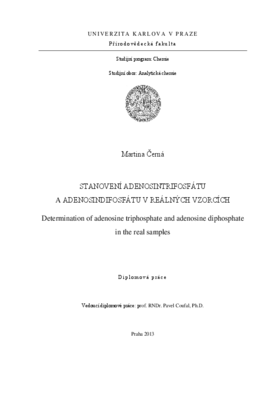Stanovení adenosintrifosfátu a adenosindifosfátu v reálných vzorcích
Determination of adenosine triphosphate and adenosine diphosphate in real samples
diplomová práce (OBHÁJENO)

Zobrazit/
Trvalý odkaz
http://hdl.handle.net/20.500.11956/54894Identifikátory
SIS: 115139
Kolekce
- Kvalifikační práce [20084]
Autor
Vedoucí práce
Oponent práce
Zima, Jiří
Fakulta / součást
Přírodovědecká fakulta
Obor
Analytická chemie
Katedra / ústav / klinika
Katedra analytické chemie
Datum obhajoby
27. 5. 2013
Nakladatel
Univerzita Karlova, Přírodovědecká fakultaJazyk
Čeština
Známka
Výborně
Klíčová slova (česky)
vysokoúčinná kapalinová chromatografie, detekce v ultrafialové oblasti, detektor diodového pole, hmotnostní spektrometrie, nukleotidyKlíčová slova (anglicky)
high pressure liquid chromatography, detection in the ultraviolet area, diod array detector, mass spectrometry, nucleotidesÚkolem tohoto diplomového projektu bylo nalézt vhodné podmínky pro stanovení dvou běžných nukleotidů adenosindifosfátu a adenosintrifosfátu pomocí vysokoúčinné kapalinové chromatografie a provést jejich analýzu v reálných vzorcích citrusových plodů a extraktů z rostlin. Dalším cílem bylo zjistit limity detekce a stanovení obou nukleotidů při těchto optimalizovaných podmínkách měření a pomocí těchto limitů porovnat citlivost používaných detektorů. K zjištění zkoumaných nukleotidů byly využity instrumentace HPLC-UV, kapilární HPLC-DAD a HPLC-MS. Pomocí HPLC s UV detekcí a kapilární HPLC s detektorem diodového pole byly proměřeny kalibrační závislosti směsi analytů a určeny limity detekce a stanovení adenosindifosfátu a adenosintrifosfátu. K rozdělení analytů až na základní linii pomocí HPLC-UV a kapilární HPLC-DAD došlo za podmínek iontově párové chromatografie. Vhodnou kolonou byla kolona C18. Mobilní fáze obsahovala fosfátový pufr, acetonitril a tetrabutylamonium bisulfát jako iontově párové činidlo. Dělení probíhalo při gradientové eluci. U LC-MS byly zjišťovány podmínky analýzy ADP a ATP. Při vysokoúčinné kapalinové chromatografii s hmotnostní detekcí bylo dosaženo rozdělení analytů na koloně C18, fenyl-hexylové koloně a koloně Zic HILIC. Mobilní fáze protékající kolonou C18 obsahovala 99:1 (v/v)...
The aim of the diploma thesis was to find optimal conditions of high pressure liquid chromatography for the detection and quantification of two common nucleotides, namely adenosine diphosphate and adenosine triphosphate, as well as to perform an analysis of these in real life samples of citrus fruits and plant extracts. Further aim of the project was to determine the limits of detection and quantification of adenosine diphosphate and adenosine triphosphate under the optimized conditions and using these to compare the sensitivity of given detectors. To achieve this HPLC-UV, capillary HPLC-DAD and HPLC-MS apparatus were used. With the help of HPLC with UV detection and capillary HPLC with diode array detector, the calibration curves of the mixture of analytes were measured and the limits of detection as well as quantification of adenosine diphosphate and adenosine triphosphate were determined. Separation of the analytes up to the base line using HPLC-UV and capillary HPLC-DAD was achieved under the conditions of ion pairing chromatography. Column C18 was chosen as an appropriate column. The mobile phase included phosphate buffer, acetonitrile and tetrabutylammonium bisulphate as an ion pairing reagent. The separation was performed with gradient elution. Conditions for analysis using LC-MS were...
